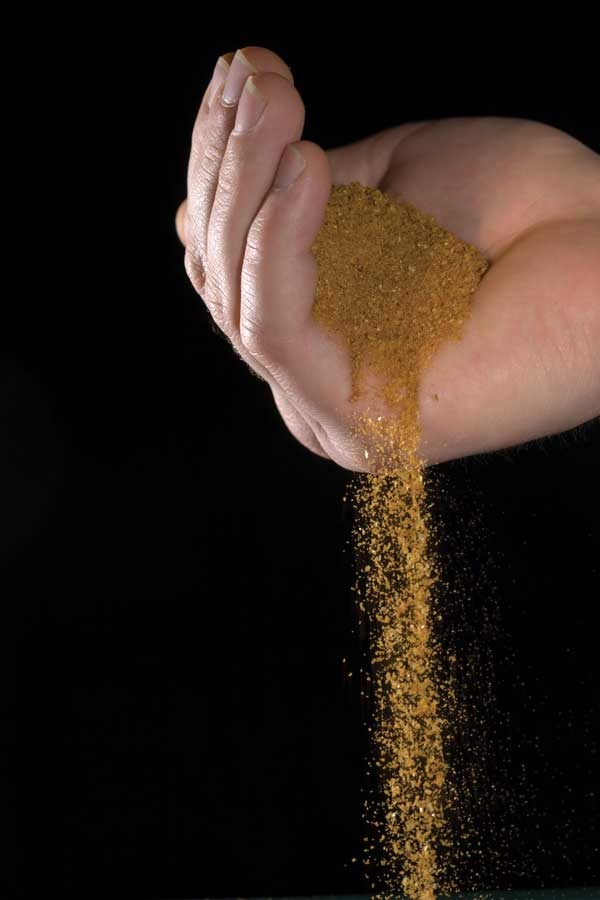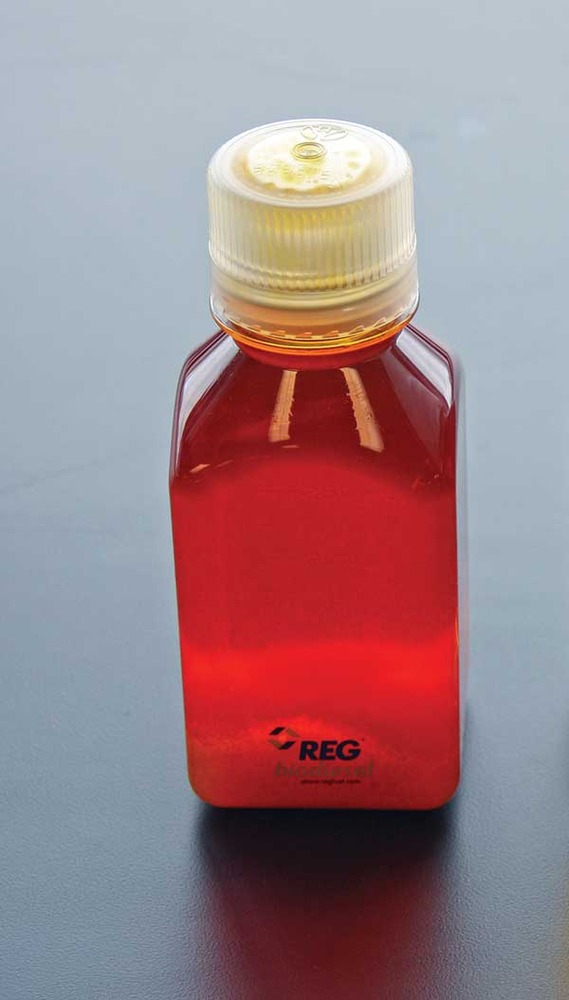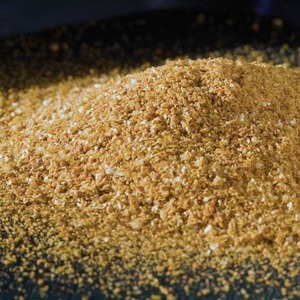Creating a Quality Image




PHOTO: UNIVERSITY OF MINNESOTA
June 3, 2015
BY Holly Jessen
In 15 years of traveling to foreign countries with the U.S. Grains Council to promote distillers grains and now distillers corn oil (DCO), Jerry Shurson says one of the most frequently asked questions is, how stable is distillers grains? Shurson, a professor in the University of Minnesota department of animal science, says it comes up in particular in Southeast Asia, where customers want to know if the oil in distillers grains and DCO will go rancid in transport or storage. “All I could tell them, up until recently, is, nobody has ever conducted a study to ask that question and find how bad or how good it could be,” he says, adding that the only small pieces of data he had were from field trials conducted in Mexico and Taiwan.
Shelf life of distillers grains and DCO is especially important anywhere the coproducts are stored in hot or humid conditions, which includes export markets like Southeast Asia as well as southern U.S. After a coproduct leaves an ethanol plant, depending on where it is going, two or even three months can pass before the end-user receives it. That includes time in transport but also just sitting at port or at a feed mill, Shurson says. An added factor is that exported coproducts are sometimes transported in containers, which are essentially sealed steel boxes that can get very hot. “These customers were asking very reasonable and legitimate questions, in my opinion,” he says. “So we were finally able to cobble together enough funding to do a fairly simple initial experiment.”
The results confirmed what researchers suspected. Peroxidation, or lipid degradation, does occur in distillers grains and DCO. “Peroxidation is an impact of time, temperature, oxygen, minerals and other factors,” says Brian Kerr, animal scientist for the USDA-Agricultural Research Service’s National Laboratory for Agriculture and the Environment, adding that it’s not unique to ethanol coproducts. Other unsaturated oils with double bonds, such as soybean oil or canola oil, also degrade over time.
Specifically, the study looked at the effects of exposing distillers grains and DCO to temperatures of 38 degrees Celsius at 94 percent relative humidity for a period of four weeks. As researchers suspected would be the case, peroxidation was greater for distillers grains samples with 13 percent oil than samples with 5 percent distillers grains. For DCO, peroxidation was greater on the DCO samples with 1.8 percent moisture, insolubles and unsaponifiables (MIU) than the samples with 1.3 percent MIU. The exciting part, Shurson says, is that applying two commercially available antioxidants did reduce damage to the samples of distillers grains and DCO. “It didn’t totally eliminate it, but it cut it by half,” he says, “which I think is pretty significant.”
Exposing More Questions
The study of peroxidation in distillers grains and DCO is the latest in a long string of related studies conducted by Shurson and Kerr, with the help of others. It started about six years ago, with research into 4-hydroxynonenal, or 4HNE, a compound found in French fries, which has been associated with Parkinson’s disease, Alzheimer’s and various forms of cancer. In other words, “a lot of nasty, adverse health effects,” Shurson says. As increasing amounts of restaurant grease is funneled into the livestock industry as a feed ingredient, Shurson and Kerr realized research was needed on what effect this has on animal health and performance.
In theory, peroxidized oils, which yield aldehydes and other undesirable compounds, have a negative effect on digestibility, Kerr says. While there have been some studies done on this topic, some are decades old, and additional study is needed as the type of lipids used in animal feed has changed over time. “We really haven’t worried much about it in the past, because it’s been minor,” he says, “but with more and different sources of lipids, such as distillers corn oil, more yellow grease, and also with competition for oil, such as the biodiesel industry using distillers corn oil, there’s a lot of different lipids out there that may become available to livestock.”
With every study completed, researchers learn more and expose more questions, Shurson says, adding that a comprehensive literature review turned up several studies showing that feeding peroxidized oils to pigs and poultry reduces food consumption, feed conversion and growth rate. “The real question is, is there a magical threshold where this happens and below that we don’t have to worry about it?” he asks, adding that he believes dietary thresholds for maximum lipid peroxidation do need to be established. “I think we’ve got a pretty strong body of evidence that indicates it’s not a good thing.”
Kerr agrees there are a lot of questions that need to be answered through additional study. Specific to the ethanol industry, one question is whether the naturally occurring vitamin E, an antioxidant, provides any protection from peroxidation. Another one is whether the heat applied to distillers grains during the drying process has an impact on lipid peroxidation.
Coproduct Evolution
When Shurson shares the results of this study, he’s commonly asked if any ethanol producers currently add antioxidants to distillers grains or DCO. “Unless I am missing something, my answer is no,” he said, adding that producers are willing to do it if customers specifically ask for it but that would likely come with an additional cost.
In that same vein, ethanol production facilities could implement changes to their individual production processes in order to produce DCO with lower MIU levels, and therefore, longer-term shelf stability. Free fatty acids, or FFAs, are another possible indicator of DCO quality. Many different parts of the production process could be tweaked to improve the quality of the DCO and distillers grains produced, including enzymes used in the process, surfactants used for corn oil extraction, process temperature and more.
Shurson hopes the results of the study will raise awareness among ethanol producers and prompt them to think about how to produce a higher quality product from a lipid standpoint. However, he suspects producers will wonder why they should spend money to tweak their production processes or add antioxidants if it won’t result in getting paid more for the coproducts. “My response to that is, it’s work that needs to be done to maintain or sustain your market,” he says. “Because if people start getting concerned about lipid degradation in corn coproducts, it may hurt your demand.”
As feed prices go up and down, there are times when nutritionists and livestock producers put more emphasis on shopping for higher-quality feed ingredients, he points out. “Even though producers won’t necessarily get paid more for doing something to improve product quality, over time it does end up paying returns by having established a reputation for better-quality products compared to lower-quality products.”
The ethanol industry has come a long way from the days when producers were trying to get rid of the ethanol process byproduct. Although the main focus is still ethanol yield, he says, in the past five years, the ethanol industry has become much more focused on the revenue it can gain from coproducts like distillers grains and DCO. More producers are diversifying their coproduct portfolio, first with corn oil extraction, and, in the future, with other coproducts, leading the industry closer to the true biorefinery model.
And, Shurson says, it’s true there are ethanol production companies, ethanol plant boards and individual managers who do pay more attention to the quality side of coproduct production. It’s a sign of progress, he says, that more ethanol producers are aligning themselves with animal feed companies, to add to their knowledge base on how to better serve their customers. And yet, Shurson would like to see an even greater emphasis on coproduct quality. “My challenge to the industry is, let’s move a little bit further in that direction, and let’s start looking at ways that individual plants can improve on minimizing some of these less desirable characteristics of the products they are producing,” he says. “They may not see immediate returns in terms of cents per pound or dollars per ton but, long term, they will be creating a quality image that hopefully will help sustain and grow the coproduct market.”
Author: Holly Jessen
Managing Editor, Ethanol Producer Magazine
701-738-4946
hjessen@bbiinternational.com
Advertisement
Advertisement
Advertisement
Advertisement
Related Stories
Saipem has been awarded an EPC contract by Enilive for the expansion of the company’s biorefinery in Porto Marghera, near Venice. The project will boost total nameplate capacity and enable the production of SAF.
Global digital shipbuilder Incat Crowther announced on June 11 the company has been commissioned by Los Angeles operator Catalina Express to design a new low-emission, renewable diesel-powered passenger ferry.
International Air Transport Association has announced the release of the Sustainable Aviation Fuel (SAF) Matchmaker platform, to facilitate SAF procurement between airlines and SAF producers by matching requests for SAF supply with offers.
Alfanar on June 20 officially opened its new office in London, further reaffirming its continued investment in the U.K. The company is developing Lighthouse Green Fuels, a U.K.-based SAF project that is expected to be complete in 2029.
ATR and French SAF aggregator ATOBA Energy on June 19 signed a memorandum of understanding (MOU) to explore ways to facilitate and accelerate sustainable aviation fuel (SAF) adoption for ATR operators.
Upcoming Events










